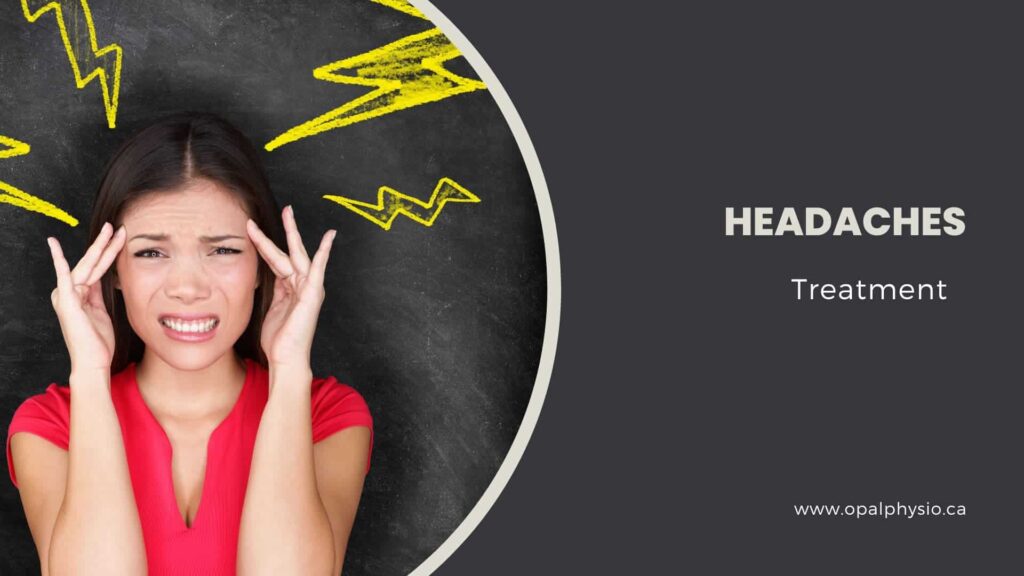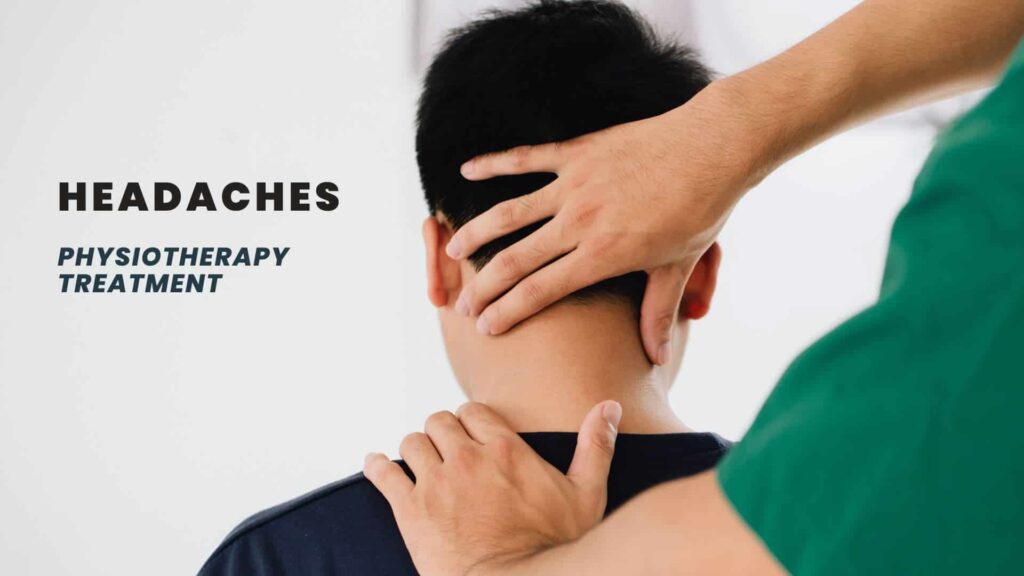Headache Treatment In Langley
Headaches are prevalent and can significantly impact quality of life. They affect around one in five people during their lifetime. While over-the-counter medications provide temporary relief, physiotherapy offers a more comprehensive approach to managing headaches.
Headaches physiotherapy treatment in Langley
At Opal Physiotherapy and Health Clinic, we specialize in providing comprehensive headache relief and treatment in Langley through physiotherapy. Our physiotherapists are dedicated to helping you manage your headaches and improve your quality of life.

What are headaches?
A headache is a pain or discomfort in the head or face area. It is a very common condition that most people will experience many times during their lives. Headaches can vary greatly in terms of the location and intensity of the pain and how often they occur.
Types of headaches
Headaches come in many different forms, each with unique characteristics. Some people experience it every day, while others hardly ever feel one.
There are over 150 types of headaches, but some of the most common that we see in our clinic include:
Tension headaches
The most prevalent type is caused by tight muscles in the head, neck and shoulders. Tension headaches often begin suddenly and worsen over time. If left untreated, they can lead to migraines. A tension discomfort is usually caused by stress, dehydration, caffeine withdrawal, fatigue, eating something you are allergic to, and staring at a computer screen for hours.
Migraines
A migraine headache is usually described as unilateral, affecting only one half of the head with nausea or light/sound sensitivity. A rare type of migraine called hemicrania continua can affect both sides of the head and is characterized by severe pain. Migraines are caused by changes in blood flow to the brain. They can occur suddenly or gradually over several days.
Cervicogenic headaches
Cervicogenic pain originates from the neck. Pain is felt at the base of the skull or radiates to the forehead. They are often accompanied by neck stiffness or pain. This type of head pain usually occurs when the muscles around the neck become tight due to stress, poor posture, whiplash, heavy lifting, traumatic injury, or even sleeping wrong.
Cluster headaches
Severe, piercing pain on one side of the face or head. Headaches occur in clusters lasting weeks or months. These are short-lived attacks that usually happen once per month. When someone experiences a cluster headache, he or she feels intense pressure behind the eyes, along with facial numbness. A person suffering from a cluster head discomfort cannot see clearly from the affected sight.
Causes of headaches:
Headaches are common medical complaints, with over 90% of adults experiencing head discomfort yearly. While head discomfort can sometimes indicate a more serious underlying condition, the majority are primary headaches – meaning another medical issue does not cause them. However, it is essential to know what causes the pain because there are several ways to treat the problem.
Muscle tension
One of the most prevalent causes of headaches is muscle tension, particularly in the neck and scalp muscles. When these muscles become tight or strained due to poor posture, injury, stress, or repetitive motions, it can lead to a tension headache. The pain is typically described as feeling like a tight band around the head. Tension head discomfort tends to be mild to moderate in intensity, with symptoms that include a dull, constant ache.
Migraines
Migraines are recurring headaches that are moderate to severe in intensity. They are thought to be caused by changes in brain chemicals and nerve signals. Certain foods, hormones, or stress can trigger it. Migraine pain is often throbbing or pulsating, affecting one side of the head. Attacks can last anywhere from 4 to 72 hours. Migraines may be accompanied by nausea, vomiting, sensitivity to light, or aura symptoms.
Hormonal changes
Fluctuations in estrogen and progesterone can trigger headaches in women. Head discomforts often occur right before or during a menstrual period due to declining estrogen. Hormone changes during pregnancy, menopause, or from birth control pills may also contribute to head discomfort. These are sometimes called “menstrual migraines” or “hormone headaches.”
Medication overuse
Taking pain relief medication more than 2-3 days per week regularly can cause headaches. The frequent use of opioids, acetaminophen or NSAIDs can make head discomfort more frequent and severe. These types of discomfort in the head often resolve once the overused medication is stopped.
Sleep disturbances
Disruptions in sleep patterns or insufficient sleep are associated with increased headache frequency. Sleep apnea, insomnia, and other sleep disorders can directly impact head pain. Changes to sleep schedules on weekends vs. weekdays can also trigger weekend migraine attacks.
Dietary triggers
Certain foods and drinks may trigger pain in the head in susceptible individuals. Common dietary headache triggers include aged cheeses, processed meats, chocolate, alcohol (especially red wine), caffeine, and foods containing the additive MSG. Dehydration and skipping meals can also induce pain in the head.
Stress and emotions
Stress, anxiety, depression, excitement, and shock can prompt headache onset. High-stress levels over long periods may increase pain frequency. Emotional and psychological factors play a significant role in chronic headaches. Learning to manage stress can help reduce head discomfort.
While most headaches are benign, any recurrent or severe headaches should be evaluated by a doctor. Keeping a head pain diary to identify triggers is helpful. Lifestyle changes, trigger avoidance, and medications can be used to manage primary headache disorders.
Our services
At Opal Physiotherapy Clinic, we offer a range of services to address the various types of headaches, including:
- Tension headaches
- Migraines
- Cervicogenic headaches
- Cluster headaches
Physiotherapy assessment
A physiotherapist will conduct a thorough assessment to determine the cause of your headaches. This includes:
- Medical history – onset, frequency, symptoms, triggers.
- Posture analysis.
- Neck and shoulder range of motion.
- Palpation of muscles and joints for tone and any tightness.
- Neurological testing
Identifying contributing factors allows the physiotherapist to identify the root cause of your headaches and design a customized treatment plan.

Physiotherapy headache treatment techniques
Our physiotherapists employ a variety of techniques to treat pain in the head, such as;
- Joint mobilization: Gentle movements to improve cervical spine and upper back mobility.
- Soft tissue massage: To release muscle tightness and trigger points.
- Dry needling: Insertion of thin needles into tight muscles to relieve spasms.
- Postural correction: Stretches and exercises to improve posture.
- Relaxation techniques: Diaphragmatic breathing, guided imagery, etc.
- Ergonomic advice: Modifications for a workstation, driving position, and sleeping posture.
- Stress management: Coping strategies for triggers like anxiety or poor sleep.
- Exercise programs: may involve strength training, aerobic exercises, flexibility exercises, and relaxation techniques.
- Education on lifestyle changes: to help reduce stress and improve overall health. This could mean changing diet habits, increasing sleep time, limiting caffeine intake, avoiding alcohol and smoking, and managing stress better.
Performing exercises regularly can provide headache relief by releasing muscle tension. Be sure to follow your physiotherapist’s personalized exercise program.
Physiotherapy offers an effective approach to managing headaches through assessment, hands-on treatment, education, exercises and more. If you suffer from frequent or severe headaches, consult with one of our physiotherapists at Opal Physio to help identify the cause and provide lasting relief.
If you are looking for headache treatment near me, contact us to learn how our physiotherapist can help with your headaches.
